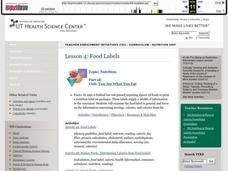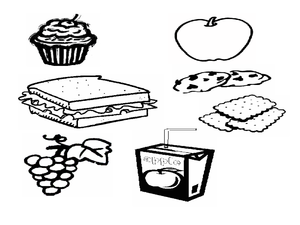Curated OER
Farm to Lunch: Exploring Agricultural Careers
Fourth graders examine Utah's economic structure and learn about agricultural careers. In this agricultural careers lesson, 4th graders follow agricultural products from their source to the lunch table. Students chart their results to...
Curated OER
Biomolecules
Students perform an experiment in which they test foods for the presence of proteins, carbohydrates, and lipids. They identify the molecular structure of each type of biomolecule and then discuss how biomolecules relate to nutrition and...
Curated OER
Dietary Guidelines for Good Nutrition
Students examine Dietary Guidelines for Americans developed by United States Department of Agriculture, analyze their diets for three days, and determine if their diets met the recommended dietary allowances (RDA) for their age and sex.
Curated OER
Introduction to Nutrition and Gardening
Young scholars examine the different parts of a plant and each ones role. In this exploratory activity students complete several activities including a game of charades.
Curated OER
Nutrition in Space
Learners compare and contrast the process of dehydration with the processes of freezing and canning. They predict energy sources that may be accessible in the future in different environments such as the moon and planets, most notably Mars.
Curated OER
Interdisciplinary Unit On Wellness
Students create a portfolio throughout their middle school years on wellness. Students explore their awareness of the connections between health, physical education, and family and consumer sciences with particular emphasis on the areas...
Curated OER
Lesson: Living With the Farm Next Door
Discuss with learners why farms are growing in size and why there is sometimes conflict between farmers and their non-farming neighbors. Read the article, "Living With the Farm Next Door," and then craft letters to the editor from the...
Curated OER
Yo! Gert-making yogurt
Young scientists or chefs culture yeast to produce yogurt. The materials and a general description of how make yogurt are provided, but there is very little detail otherwise. You could use this as an activity when your biology class is...
Curated OER
You Are What You Eat
Learners examine food labels and study serving size and calories. In this healthy eating lesson students complete several activities to understand food labels.
Curated OER
By Golly By Gum
Students identify the different steps in the scientific method. In this inquiry instructional activity, students determine the mass of the gum after chewing it for sometime. They explain what happens to the lost mass.
Curated OER
They Don't Just Eat Grass
Middle schoolers consider the USDA daily recommendations to create a "feed" product for middle schoolers. For this Health lesson, students learn about the ingredients in feed that is fed to livestock and apply the method to creating feed...
Curated OER
An Inside Look at Apples
First graders examine and identify parts of an apple. In this biology lesson, 1st graders cut an apple in half and locate all the parts, use the apple halves as stamps, and create a bar graph displaying which apple types the students...
Curated OER
Agriculture: It Doesn't Just Happen
After reading an informational text on the Agricultural Research Service, learners research the role of the ARS in Oklahoma. Using reputable online sources, they label a map of the state with relevant areas. Researchers focus on one of...
Curated OER
Testing for Life’s Molecules
Want to hear a joke about sodium? Na. Young scientists test various materials to identify if they include protein, starch, and glucose by using the Biuret test, iodine starch test, and Benedict's test respectively. After practicing with...
Curated OER
Good Enough To Eat
Students are introduced to the five food groups. In groups, they place different foods into the correct section of the Food Pyramid. Using different types of technology, they create one page of a class ABC book sharing what they know...
Curated OER
"Mush Lab"
Students use the information they learned from reading food labels to create mush meals. They blend unlikely meals together to form the mush and then evaluate its nutritional value. They examine their own eating habits after the lab is...
Curated OER
Pyramid Play
Students investigate the concept of the Food Pyramid. They use a game as a tool of discovery in order to classify different types of food in the pyramid. Upon completion of the game the students construct their own models of it.
Curated OER
Engineering and the Senses
Students explore nutrition. In this nutrition lesson, students discuss a person's sense of taste and how it is different for each person. Students discuss favorite foods and how they relate to nutrition. Students cut out pictures of...
Curated OER
Feeding Your Fish
Students discuss nutrition and diet. They look at copies of Tetra's Daily Nutrition Pyramid for Tropical Fish. They compare the fish feeding pyramid to the pyramid for human nutrition. Students examine a can of fish food.
Curated OER
Peanuts
Students explore the benefits of peanuts. In this peanut lesson plan, students explore the nutritional benefits of peanuts as they complete worksheet activities.
Curated OER
Label Language
Sixth graders explore healthy eating habits by identifying food labels. In this food ingredient lesson, 6th graders discuss the nutritional facts that are available on almost all foods in America and which ingredients and content is...
Curated OER
Rosa Parks Community Garden
Students explore gardening and nutrition in the Rosa Parks Community Garden. They work in stations to discuss food choices, the life cycles of plants, and mini-composting. After starting in one station, they rotate to try each activity.
Curated OER
St. Patrick's Day Snack
First graders design a green snack menu from all four food groups for St. Patrick's Day.
Curated OER
The Energy Equation
Students explore human energy components. In this personal health lesson plan, students determine how food, sleep, and exercise impact human energy levels as they play BAM! Body and Mind interactive games. Students create motivational...

























